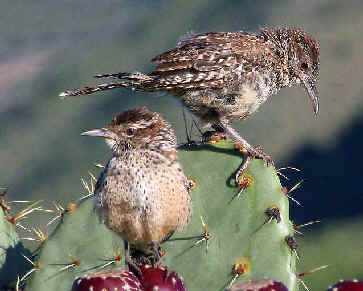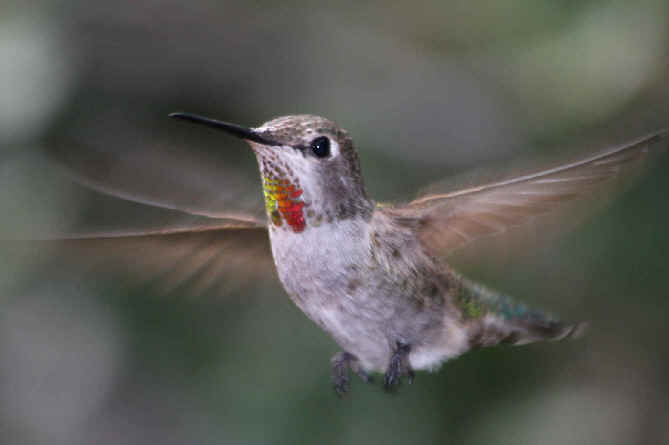
E-mail: tours@focusonnature.com
Phone: Toll-free in USA 1-888-721-3555
or 302/529-1876
 |
PO Box 9021,
Wilmington, DE 19809, USA E-mail: tours@focusonnature.com Phone: Toll-free in USA 1-888-721-3555 or 302/529-1876 |
THE
FOCUS ON NATURE TOUR IN SOUTHERN ARIZONA & NORTHERN MEXICO
August/September 2008

Cactus Wrens
(photo during a FONT tour by Doris Potter)
Links:
Birds
& Other Wildlife during our southern Arizona & northern Mexico Tour in
Aug-Sep '08
A
List & Photo Gallery of Arizona Birds, in 2 parts
A List & Photo Gallery of Mexico Birds, in 3 parts:
Part #1: Tinamous to Shorebirds
Part #2: Jaegers to
Woodpeckers
Part #3: Manakins to Buntings
Mammals (a list with some photos) in:
Arizona
Mexico
Amphibians &
Reptiles (a list with some photos) in:
Arizona
Mexico
Arizona Butterflies and Dragonflies & Damselflies (with some photos)
Upcoming FONT Birding & Nature Tours in Arizona
Upcoming FONT Birding & Nature Tours in Mexico
The following narrative was written by Armas Hill, leader of the tour:
For
a number of years, during the second half of the summer, FONT has been going to Arizona, primarily to see the
hummingbirds that also go to that state at that
time, but also other birds too. In all, nearly 150 species of birds have been
seen during the FONT tours in Arizona in the late-summer.
In 2008, this annual tour was a little later that it was other years. It was at
the very end of August, and spilled into
September. The dates were
August 28 to
September 4, 2008.
Being later, and further into the migration, a few species were seen in Arizona
for us for the first time. Among them, the MacGillivray's Warbler was
particularly common. There were a couple Sparrow species that we had not seen,
other years, when the tour was earlier, the Savannah and Vesper. A single
Osprey
in a treetop at a day's end, no where near water, was also "new" for
us for Arizona. And there were two species that we saw that normally range east
of Arizona, the Northern Parula and the Yellow-throated Vireo.
But one of our "new" bird species for Arizona
was especially notable.
It was a species not ever seen, not only by us, but by anyone, prior to the end
of August 2008, not only in Arizona but anywhere north of Mexico, where the bird
is endemic. Seeing a "new species" for the US, or for North America
north of the Mexican border, is a hard to do!
In all, over 800 species of birds have been noted in North America as just
defined - that is, North America north of Mexico. Of those, over 700 species are
regular, either widespread or local, in that part of the continent north of
Mexico. Others are vagrants, that have occurred either at sea, or usually at the
edge of the land mass, in remote places such as Alaska and Newfoundland. Other
rarities for the region have also been at or near its edge, in Texas, New
Mexico, Arizona, and California.
The particular bird, being referred to here, as being in
Arizona, is a
wren.
It's named for a Mexican
state, Sinaloa, although the species also occurs in a
state that's further north and closer to the US, that is the border state of
Sonora.
The wren, now known as the Sinaloa Wren, was formerly called the Bar-vented
Wren. It's a Mexican endemic (even with the new Arizona occurrence
notwithstanding).
Mexico is a country rich in wrens. 29 species occur. That's more than in any
other country. Among them, 11 are endemic to Mexico: the Gray-barred, Giant,
Spotted, Boucard's, Yucatan, Sumichrast's, Nava's, Happy, Socorro, and the Clarion, in addition to the
Sinaloa.
Putting all them together would be quite a collection of song. Putting all 29
Mexican species together would be a symphonic blast!
Incidentally, in addition to the Sinaloa Wren (as noted, just found in Arizona),
there are 2 other wren species that occur regularly and in numbers in Sonora and
have not been found north of the border: the Spotted and the Happy
Wrens, with
the former not yet "spotted", and the latter apparently happy to be
where it is.
We went during two consecutive mornings to the place with that first Sinaloa
Wren visiting north of the Mexican border. Both of those mornings, there were
numerous birders, from a variety of places themselves, hoping to get a look at
the bird. Most, those two mornings, did not. A few heard the bird, giving its
call, or a bit of a song, in the distance. Some got but a glimpse. Our
experience was like that. On the other side of a stream, the call-note of the
Sinaloa Wren was heard. Two wrens were detected in the underbrush. But when one
appeared. it was a Bewick's Wren. Birds of the two species were apparently
associating together.
So, we decided to go back again - later during our tour, on our way back from
the Chiricahua Mountains back to
Tucson. It would not be at what would normally
be thought of as the best time in the morning, and there probably would not be a
crowd of other birders, but even so, we decided to visit the place again.
That place, by the way, was just south of the town of Patagonia, along a dirt
road near the sanctuary of the Nature Conservancy. That's where the bird had
been since it was found.
We learned about the wren, by the way, during our visit on the first day of our
tour, at the store and office of the Tucson Audubon
Society, where we always
stop for a visit at the beginning of our tours in the area. It was kind of them,
at Tucson Audubon, to tell us, right away, about the rarity, found the previous
day, that was a first, as noted, not only for southern Arizona, but for North
America north of Mexico.
Anyway, when we went back to the wren's favored site that afternoon, a couple
days after our previous two morning visits, we were most fortunate! It was about
3:45pm. As we drove slowly, along the dirt road, I heard some sounds of bird
activity in trees at what certainly turned out to be the right place. We saw,
first, some Bridled Titmice, and then the Northern Parula that had been seen by
others and by us during the mornings a few days earlier.
But wrens were detected in the underbrush. One or two Bewick's Wrens were
present. And then we heard the call, as we had a few days previously, of the
Sinaloa Wren. But not only that, then the bird came out onto the dirt road and
took a dust bath right in front of us! Of course, we saw it well. But yet there
was to be more. The Sinaloa Wren then went onto a branch, at about eye-level,
only yards from us, and sang its hearty song. We saw every feature of the
bird.
There's an expression that "it's not over until the fat lady sings".
Well, it was over for us, after that little Sinaloa Wren from Mexico belted out
its rich song in front of us in clear view! It was certainly the "right
way" to see a "good bird"!
There were some other birds that were seen nicely during our Arizona tour in
August/September '08.
The cast of sparrows one day was pretty good, east of Patagonia in the scenic
San Rafael Valley. That day we saw:
Cassin's, Botteri's, Grasshopper, Vesper,
Lark, Song, and Savannah. The last of these arrives in southern Arizona in
August. A number of sparrows and related birds, and an assortment of hawks
winter in that picturesque valley. During our day there, a notable raptor for us
was a White-tailed Kite.
And of course there were, during our 2008 Arizona
Tour, the
Hummingbirds! We saw
a dozen species, in various plumages, and all of them we saw
well. There were, of course, the regulars, including: the Broad-billed, the
"Rivoli's" form of the Magnificent, the Blue-throated, the
Anna's, the Black-chinned, the Broad-tailed, and the Rufous. Telling some
Rufous
Hummingbirds from the Allen's Hummingbird can be problematic, but we saw both.
And we also saw nicely the Calliope Hummingbird, the smallest of all North
American birds.

This fine photograph of an immature Broad-tailed
Hummingbird
was taken during the FONT tour in southern Arizona in August 2008
by tour participant, Doris Potter.
As our tour continued, we crossed the border from the
We headed toward a place that was to be special to us, for the birds
and the other nature that we would experience there. It's the property of a
large ranch, about 30,000 acres, in the
Wildlife does abound in the area. Pumas are said to be common.
Deer and Coyote are as well. Many birds occur. During our
tour, both Montezuma and Elegant Quail were found. In one of the
canyons, we found Rufous-capped Warblers. A Mexican Yellow Grosbeak was
seen, as were Five-striped and Rufous-winged Sparrows. The last of
these species can be seen locally in southern
In all, we saw a good number of birds, of about 70 species, on and near the
property of the ranch.
What probably is best about where we were in the remote hills of Sonora is that
it IS NOW, as places such as Arizona WERE in the past - before the
"development" brought highways, agriculture, and many people. On the
property in
Oh, there are some cattle on the ranch, but not many. As one traveled about on
the property on tracks in a four-wheel drive vehicle, one had the opportunity to
sense, during our visit, what a "natural place" could really be like -
and how it was before the highways, agriculture, and many people.
I thought, more than once, as I was in those Sonoran hills, that a place in the
There are a lot of birds and other nature in those Sonoran
hills. One of the more notable of the birds is the Mexican
subspecies of the Wild Turkey, known as the "Gould's
At one point, as we were driving, we noted a huge flock of birds kettling in the
sky, hundreds of them, maybe a thousand. A look in the binoculars showed them to
be Ravens.
Also in the region, numerous birds occur at